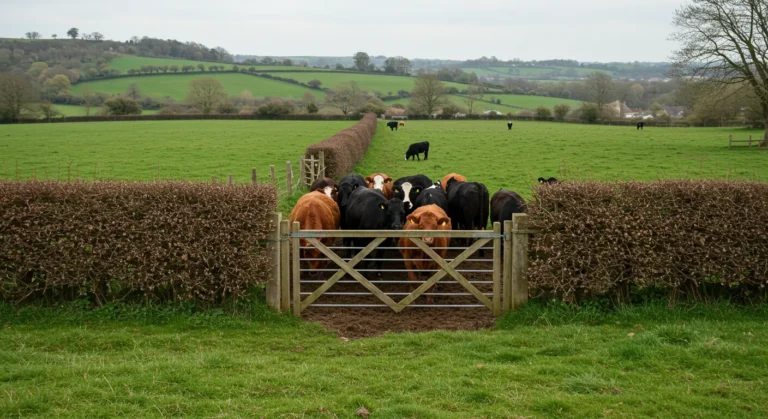Introduction
A hedge with a rail used for confining cattle is a traditional yet effective method of livestock management, particularly in rural and farming areas. It is a natural barrier and a structural reinforcement to keep cattle securely contained. In the UK, where sustainable farming practices are valued, using hedgerow fencing for livestock combined with fencing rails is an eco-friendly and efficient solution.
What is a Hedge with a Rail?
A hedge with a rail combines a living hedge—typically composed of dense shrubs or small trees—and a sturdy wooden or metal rail that provides additional security. This setup prevents cattle from pushing through the hedge while offering protection against external threats. It is one of the best UK cattle fencing methods for its durability and sustainability.
Benefits of Using a Hedge with a Rail for Cattle Confinement
- Natural and Sustainable – Hedgerows support biodiversity, providing birds, insects, and small mammals habitats.
- Strong and Durable – Combining thick hedges and sturdy rails ensures long-lasting cattle fencing solutions.
- Weather Resistance – Unlike standalone fences, hedges reduce wind exposure, providing cattle a more sheltered environment.
- Low Maintenance – Once established, hedgerows require minimal upkeep compared to traditional agricultural fencing UK solutions.
- Improved Aesthetics – Unlike plain metal fences, a hedge with a rail enhances the landscape and blends seamlessly into the countryside.
- Cost-Effective – While the initial setup requires effort, the long-term maintenance costs are lower than replacing worn-out fences.
Best Plants for Hedgerows in the UK
To create an effective hedge for cattle confinement, farmers in the UK typically use:
- Hawthorn – Fast-growing, dense, and thorny, making it an excellent choice for containment.
- Blackthorn – Similar to hawthorn but with sharper thorns and denser growth.
- Hazel – Provides strong structure and is commonly interwoven for extra stability.
- Field Maple – Offers excellent resilience and adds variety to hedgerows.
- Beech – Retains its leaves in winter, offering year-round coverage.
Choosing the Right Rails for Cattle Confinement
To reinforce the hedge, a rail system is installed, often using:
- Pressure-treated wooden rails – Durable and weather-resistant.
- Galvanized metal rails – Stronger and longer-lasting, but may require higher investment.
- Electric fencing – Used as an additional deterrent for more aggressive cattle breeds.
Installation Guide: How to Build a Hedge with a Rail for Cattle
- Planning the Area – Identify the perimeter where you need to confine cattle and mark the boundary.
- Preparing the Soil – Dig a trench along the boundary to plant hedgerow saplings.
- Planting the Hedge – Space plants approximately 30–40 cm apart to allow dense growth.
- Installing the Rails – Position wooden or metal posts at regular intervals (2–3 meters apart) and secure rails between them.
- Allowing Growth – Maintain the hedge by trimming once or twice a year to encourage thick, bushy growth.
- Checking for Gaps – Ensure there are no weak spots where cattle could push through.
Maintenance Tips for Long-Lasting Cattle Fencing Solutions
- Prune hedges annually to maintain density and structure.
- Check for gaps where livestock could push through and reinforce with extra rails if necessary.
- Monitor rail integrity for any signs of rot or damage, replacing weakened sections promptly.
- Weed control around the base to ensure healthy hedge growth.
Legal Considerations for Cattle Fencing in the UK
In the UK, farmers must comply with countryside stewardship guidelines, ensuring hedgerows do not disrupt natural habitats. Additionally:
- Boundary disputes should be resolved by checking land ownership records before installation.
- Protected hedgerows must not be removed without necessary permissions from local councils.
- Livestock fencing laws require farmers to ensure animals cannot stray onto roads or neighboring properties.
Conclusion
A hedge with a rail for confining cattle is a practical, sustainable, and visually appealing solution for UK farmers. With the right choice of plants and rails, this method provides excellent security for livestock while enhancing the surrounding environment. Investing in a well-maintained hedge and rail system ensures cattle safety and supports eco-friendly cattle fencing practices and farm boundary security.
Read More : Bright Green Spider UK
Frequently Asked Questions (FAQs)
Q1: How long does it take for a hedge to grow enough for cattle confinement?
A: Typically, a hedge takes 3–5 years to become dense enough for cattle confinement, but the rails provide immediate security.
Q2: Can I use electric fencing with a hedge and rail system?
A: Electric fencing can be added to reinforce the barrier, especially for more substantial or more aggressive cattle breeds.
Q3: What is the best time of year to plant hedgerows?
A: The best time to plant hedgerows in the UK is during late autumn to early spring when the soil is moist.
Q4: Are there grants available for hedge planting in the UK?
A: The UK government offers Countryside Stewardship grants to support farmers in planting and maintaining hedgerows.
Q5: How can I prevent cattle from damaging the hedge?
A: Using strong wooden rails and reinforcing weak spots with additional fencing will help protect the hedge from livestock damage.
By implementing traditional farm enclosures such as a hedge with a rail, farmers can achieve secure, sustainable, and visually appealing livestock enclosures while contributing to biodiversity and environmental conservation.

